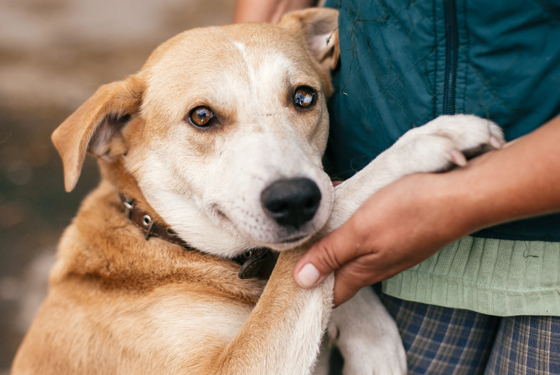The ears of a dog
The ears are a dog’s second most important sensory organ. Like its nose, they are highly sensitive multi-tasking organs. If they become dirty or infected, it is important to clean and treat them in an appropriate way.
Our dogs’ ears
Dogs’ ears can be small or large, short or long, pointed or rounded, upright or droopy. They have an enormous variety of shapes and sizes. Their ears can also be hairy or almost bare, and anything from barely noticeable to clearly visible even from a distance. What they all have in common is that they are vastly superior to our ears. However, not all of them to the same extent. While large prick ears are almost like satellite dishes, small floppy ears are not quite as powerful. There are no significant differences in the frequency range: regardless of the shape of their ears, dogs can hear high-pitched sounds up to 45,000 Hz. For us, the limit is around 16,000. Correspondingly, while some people can only hear dog whistles to a very limited extent, dogs experience them in the mid-frequency range. For them, it is no problem at all to hear the squeaking of a mouse.
Special functions of a dog’s ears
Dogs can not only hear both very soft and very high-pitched sounds, but can also determine the direction from which the sound is coming. Unlike us, they can swivel their ears almost 360 degrees with the help of 17 muscles. They are able to do this with each ear individually: while one is directed forwards, the other can scan the area behind the dog. This allows three-dimensional hearing. In theory, this tremendous hearing capability means that dogs are subjected to constant noise. However, dogs have a trick to prevent this: their sensory cells are not connected directly to the ears, but to the brain – via nerve tracts. These can be switched on and off more or less like a light switch. For their everyday lives, this means that they can block out background noises from, for example, the television or a vacuum cleaner. They deactivate their ears, so to speak, and as a result are able to relax better.
Impairments of dogs’ ears
Dogs’ ears are self-cleaning organs. Countless tiny hair cells inside the ear ensure the removal of excess earwax. In addition, larger hairs prevent the penetration of dirt and dust to a large extent. Unfortunately, however, this self-cleaning process does not always work perfectly. Sometimes soil, sand, awns or grasses get stuck in the ears. Similarly, there can be an infestation of parasites, often mites. Most at risk are dogs with floppy ears, which are prone to fungi and bacteria due to the warm, humid environment.
Symptoms of ear disorders
It is not uncommon for dogs to scratch themselves. Itches here and there are no problem at all. However, if a dog is seen frequently rubbing its ears with its front paws or scratching them vigorously with its hind paws, then this can indicate a problem. Even if you cannot actually observe your dog scratching, make sure that you check the inside and outside of its ears for scratch marks. Typical symptoms are also frequent shaking or tilting of the head. In such cases, you should take a closer look at the ears. First examine them from the outside to see whether, for example, awns have become attached or a tick has bitten into the dog’s ear. If you cannot see anything here, take a look in the ears in bright light. You may be able to see a foreign body there. Also check for any changes in colour: black spots, redness, dandruff or scabs indicate a mite infestation or an infection. Another indication can be if the ears have an unpleasant smell or if the dog reacts very sensitively when being touched.

What to do if your dog’s ears are inflamed
If your dog shows typical signs of earache and you cannot remedy it yourself, for example by removing a tick, taking out a small twig or brushing out sand, you should take it to the vet. Using the right instruments, they will be able to find the cause of your pet’s ear ailment. Mites, for example, can be clearly identified under the microscope with an ear swab. It is also possible to determine if there are foreign bodies in the ear, if the eardrum is damaged or if there is an excessive amount of earwax present. Based on the results of the examination, the vet will provide or recommend the appropriate treatment.
Ear mites in dogs
If the diagnosis shows an infestation of ear mites, this is not particularly dangerous, but should nevertheless be treated immediately. The bites of the little parasites will cause the dog to suffer from extreme itching. Allergic reactions and bacterial skin infections can also occur. There is also a high risk of transmission to all other animals with which the dog comes into contact.
There are several treatments available for ear mites: First of all, the vet will probably clean the dog’s ears. Then a spot-on product or an ointment can be used to combat the mites. This is applied directly to the inflamed areas. This usually has to take place over a period of at least three weeks. Any other dogs living in the household should also be treated following consultation with the vet. Also, do not forget to thoroughly clean all the places where the dog sleeps and rests.
Cleaning your dog’s ears
To prevent ear infections or to help treat them, it may be necessary to clean your dog’s ears regularly. Typical home remedies include olive oil and coconut oil, but it is better to use a special ear cleaner. This is dripped directly into the ear and massaged in gently. Most pets will not find this unpleasant and will be willing to let you do this. Afterwards, the dog is allowed to thoroughly shake its head, as this will remove loose debris. You can then use a cloth to clean easily accessible parts of the ear from the inside to the outside. Do not use cotton buds, as this could push secretions further in. When the ears have recovered, the removal of excess earwax will start to work automatically again.
You may also like this

Removing ticks
Ticks should be removed as soon as possible

Dangerous food for your dog
You should not give these food items to your dog

Allergies in dogs
Common allergies and treatment options

Fever in dogs
What to do if your dog has a high temperature and feels poorly
